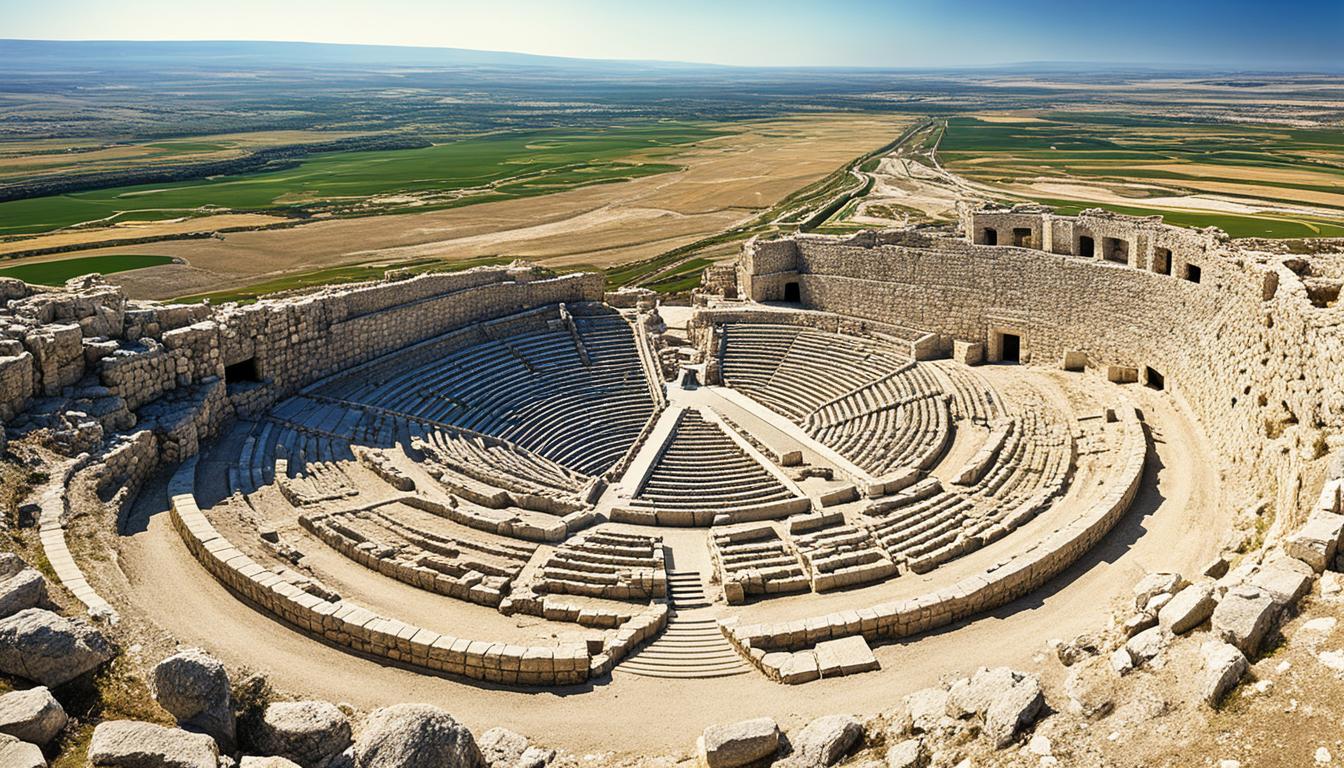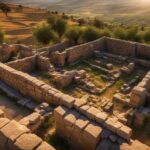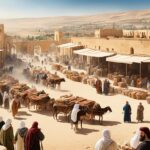Megiddo, a significant location mentioned 12 times in the Old Testament and once in the New Testament as Armageddon, holds great biblical significance. It is believed to be the site of the final battle that will occur in the end times, as prophesied in the book of Revelation. The Greek word for Armageddon, Harmagedon, translates to “the hill of Megiddo.” Situated in northwest Israel on a 35-acre mound called Tell el-Mutesellim, Megiddo has deep biblical roots and attracts many Christians to visit.
Key Takeaways:
- Megiddo is mentioned multiple times in both the Old and New Testaments, symbolizing the final battle in the end times.
- The significance of Megiddo in biblical prophecy has shaped theological beliefs associated with the site.
- The archaeological excavations at Megiddo provide valuable insights into the ancient world and biblical history.
- Megiddo’s strategic location on the Via Maris trade route and its access to the fertile Jezreel Plain made it a coveted battleground in ancient times.
- The exploration of Megiddo allows us to deepen our understanding of biblical history and its cultural and religious context.
Historical Significance of Megiddo
Megiddo, with its long history of battles and wars, holds immense historical significance. Throughout its existence, the site has witnessed 34 wars, making it a prominent battleground in ancient times. Nations from various regions fought fiercely to control Megiddo, recognizing its strategic location on the Via Maris trade route and its access to the fertile Jezreel Plain.
The battles at Megiddo in the Bible are testament to its crucial role in shaping the political landscape of the ancient world. The site’s archaeological excavations have yielded valuable artifacts and insights into the historical and biblical significance of Megiddo.
“Megiddo has witnessed numerous fierce battles throughout history, cementing its reputation as a strategic stronghold and coveted prize.”
– Dr. David Ben Shlomo, Archaeologist
Biblical archaeology at Megiddo has shed light on the ancient civilizations that inhabited the region, offering glimpses into their warfare tactics and sociopolitical structures. The excavated remains of palaces, temples, fortifications, and water systems have provided archaeologists with a wealth of knowledge, contributing to our understanding of the ancient world and biblical history.
Megiddo’s significance as a battleground and its archaeological discoveries continue to captivate researchers and visitors alike, cementing its place as a significant site in biblical archaeology.
“Megiddo’s archaeological treasures offer a unique glimpse of the past, allowing us to explore the ancient world and the civilizations that shaped it.”
– Dr. Rachel Kohn, Archaeologist
Geographical Location of Megiddo
Megiddo is situated in northern Israel in the Jezreel Valley, also known as the Valley of Megiddo. It is located near the Megiddo Junction, which connects lower Galilee to central Israel. The site lies west of the Carmel Mountain range and east of the Jordan Valley. The vast plain surrounding Megiddo has played a crucial role in the historical battles fought there.
Archaeological Discoveries at Megiddo
Megiddo, with its rich history and biblical significance, has been a treasure trove for archaeological discoveries. Over the course of a century, extensive excavations have provided valuable insights into the material culture of ancient civilizations.
- Uncovered structures: The archaeological digs at Megiddo have revealed a multitude of structures that showcase the city’s past grandeur. These include palaces, temples, fortifications, and intricate water systems.
- Sacrificial altar: One notable discovery is an ancient sacrificial altar dating back to the Early Bronze Age. This finding offers a glimpse into the religious practices of the ancient inhabitants of Megiddo.
- Royal official’s seal: Another significant artifact found at Megiddo is a seal belonging to a royal official from the reign of Jeroboam II. This discovery sheds light on the administrative hierarchy and governance of the city during biblical times.
- Evidence of destruction and occupation layers: Through careful excavation, archaeologists have unearthed evidence of destruction and occupation layers throughout Megiddo’s history. These layers provide valuable chronological data and contribute to our understanding of the city’s turbulent past.
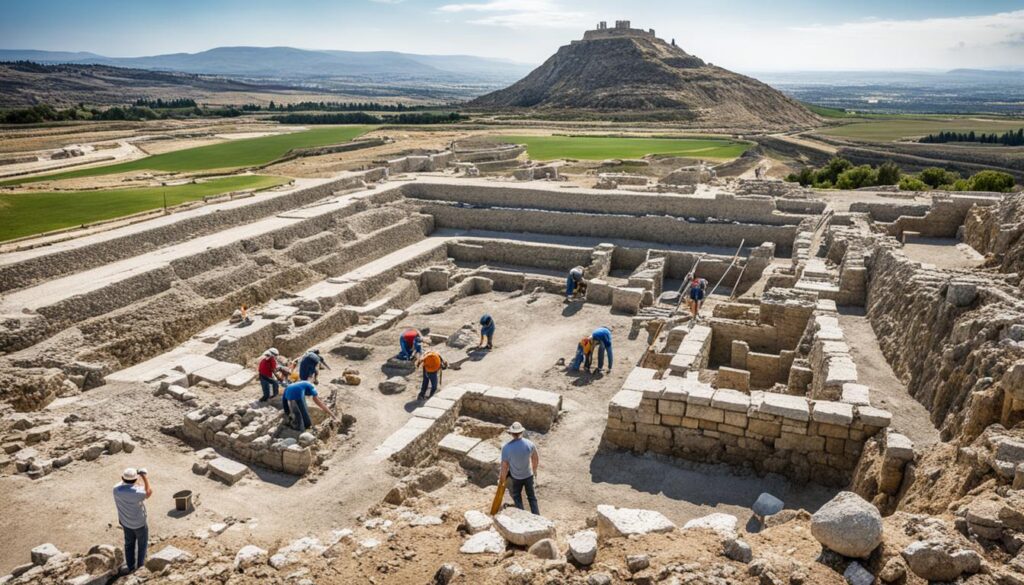
The ongoing archaeological exploration at Megiddo continues to yield fascinating finds, augmenting our knowledge of ancient civilizations and biblical archaeology.
Theological Themes Associated with Megiddo
Megiddo holds immense theological significance in Christian belief, primarily due to its association with the final battle described in the book of Revelation. This battle, commonly known as Armageddon, symbolizes the ultimate conflict between good and evil.
In the biblical narrative, the Battle of Armageddon takes place at Megiddo, where the forces of evil gather against God’s righteous people. It is believed that during this apocalyptic event, the clouds will open, and God will intervene to deliver His people from the clutches of evil, ushering them into the eternal bliss of heaven.
And I saw the beast, the kings of the earth, and their armies, gathered together to make war against Him who sat on the horse and against His army. Then the beast was captured, and with him the false prophet who worked signs in his presence … These two were cast alive into the lake of fire burning with brimstone. And the rest were killed with the sword which proceeded from the mouth of Him who sat on the horse. And all the birds were filled with their flesh. – Revelation 19:19-21
The theological significance of Megiddo in Revelation extends beyond its depiction as a physical location. It represents the final battle and the ultimate triumph of good over evil. This concept has shaped eschatological beliefs and teachings within Christian theology regarding the end times and the final victory of God’s righteous kingdom.
The mention of Megiddo in the book of Revelation has inspired extensive theological interpretations and speculation throughout history. It has sparked discussions about the nature of prophecy, the fulfillment of divine promises, and the eschatological destiny of believers. The prophetic significance of Megiddo invites reflection on the grand cosmic narrative of redemption and the ultimate victory of God’s kingdom.
In summary, the theological themes associated with Megiddo resonate deeply within Christian belief. This ancient site holds profound spiritual significance as it represents the climactic battle between good and evil, as foretold in the book of Revelation. Understanding the theological implications of Megiddo enriches our understanding of eschatological teachings and the broader biblical narrative.
Key Biblical Events at Megiddo
Megiddo, a site mentioned in the Old Testament, holds significance in relation to several key biblical events.
One notable event is the construction of King Solomon’s stables at Megiddo. Solomon, known for his wisdom and wealth, built stables to house his horses and chariots. This demonstrates the importance of Megiddo as a hub for military operations in ancient times.
“And Solomon had forty thousand stalls of horses for his chariots, and twelve thousand horsemen.” – 1 Kings 4:26
Another significant event related to Megiddo is the Battle of Megiddo, during the reign of King Josiah of Judah. In an attempt to prevent Pharaoh Neco II from passing through his territory, Josiah engaged in battle but was fatally wounded.
“Then the archers shot at King Josiah, and the king said to his servants, ‘Take me away, for I am severely wounded.’” – 2 Chronicles 35:23

These biblical events highlight the historical and biblical significance of Megiddo. From the grand stables of a wise and powerful king to the tragic battle that claimed the life of a righteous leader, Megiddo’s presence in biblical narratives showcases its importance in the ancient world.
| Biblical Event | Scripture Reference |
|---|---|
| Construction of King Solomon’s stables at Megiddo | 1 Kings 4:26 |
| Battle of Megiddo and King Josiah’s death | 2 Chronicles 35:23 |
Cultural and Religious Practices at Megiddo
Megiddo, once a thriving city, was not only a center of political and military significance but also a hub of cultural and religious practices. As it endured occupation throughout different periods, its inhabitants showcased the evolving cultures and religious beliefs of the time.
The Jezreel Plain, with its rich agricultural lands surrounding Megiddo, played a crucial role in influencing the daily lives and religious practices of the people who lived there. The fertility of the land allowed for prosperous agriculture, contributing to a flourishing society that thrived on the abundance of resources.
Religious Practices
The religious practices at Megiddo reflected the beliefs and rituals of the ancient Near Eastern civilizations. The inhabitants of Megiddo engaged in various religious ceremonies and worshiped a pantheon of deities associated with nature, fertility, and the forces that governed life. These practices often involved offerings, sacrifices, and rituals to appease and seek favor from the gods.
“We honor the gods with our offerings, seeking divine guidance and protection for the well-being of our community and land.”
The inhabitants of Megiddo built religious structures such as temples and shrines to venerate their deities, providing a place for communal worship and spiritual connection. These sacred spaces were central to the religious life of the city and served as a gathering point for the community to come together in devotion and reverence.
Cultural Practices
The cultural practices at Megiddo encompassed various aspects of daily life, including social customs, arts, crafts, and trades. The city was a melting pot of diverse cultures, influenced by the interactions and exchanges with neighboring civilizations and the people who traveled through the region.
Artistic expression flourished in Megiddo, with artisans and craftsmen creating intricate pottery, jewelry, and decorative objects adorned with symbolic motifs and designs. These artifacts not only served utilitarian purposes but also carried cultural and religious significance, reflecting the beliefs and values of the society.
“Through our crafts and arts, we preserve our cultural heritage, telling stories of our people and passing down traditions to future generations.”
Music, dance, and storytelling were also integral parts of the cultural fabric of Megiddo. Gatherings and celebrations witnessed performances that entertained, educated, and preserved the collective memory of the community, reinforcing cultural identity and fostering social cohesion.
Key Cultural and Religious Practices at Megiddo
| Cultural Practices | Religious Practices |
|---|---|
| Artistic expression: pottery, jewelry, decor | Rituals and ceremonies to appease deities |
| Music, dance, storytelling | Building temples and shrines for worship |
| Customs and traditions | Offerings and sacrifices |
This diverse and vibrant cultural and religious tapestry shaped the daily lives of the people of Megiddo, leaving behind traces and artifacts that provide valuable insights into their beliefs, practices, and aspirations.
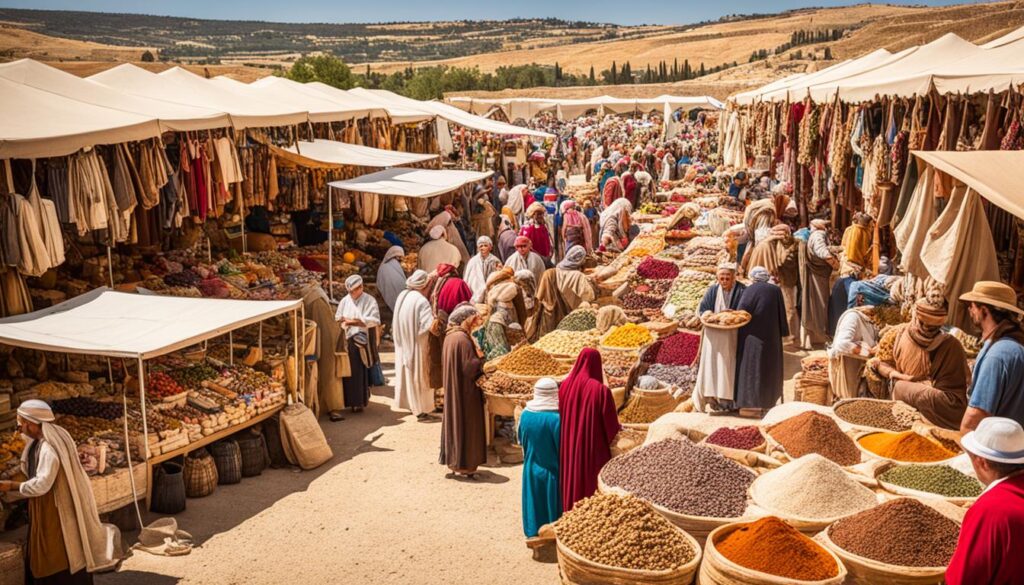
Prophetic and Eschatological Significance of Megiddo
Megiddo holds immense prophetic and eschatological significance in both biblical texts and Christian belief. At the heart of this significance lies the final battle, known as Armageddon, which is believed to mark the end times and the ultimate triumph of good over evil.
The powerful imagery surrounding Megiddo in biblical prophecy has shaped eschatological teachings and interpretations of the biblical prophecies that revolve around this ancient site. As mentioned in the book of Revelation, Armageddon symbolizes the ultimate conflict between the forces of evil and the divine intervention that will signal the restoration of harmony and the establishment of a new order.
“I saw the beast and the kings of the earth with their armies gathered to wage war against the rider on the horse and his army. But the beast was captured, and with it the false prophet who had performed the signs on its behalf.” – Revelation 19:19-20
Megiddo’s association with the final battle has captured the imagination of believers, and the significance of this prophetic event continues to be a subject of study and interpretation. The belief in the fulfillment of biblical prophecy at Megiddo fuels theological discussions and influences eschatological teachings within the Christian community.
As we explore Megiddo’s historical battles, archaeological discoveries, and its cultural and religious practices, it becomes evident that the prophetic and eschatological significance of this ancient site reaches far beyond its geographical location in Israel. Megiddo’s role in biblical prophecy serves as a reminder of the enduring power of faith and the belief in a future where good will ultimately prevail, providing hope and inspiration to believers.
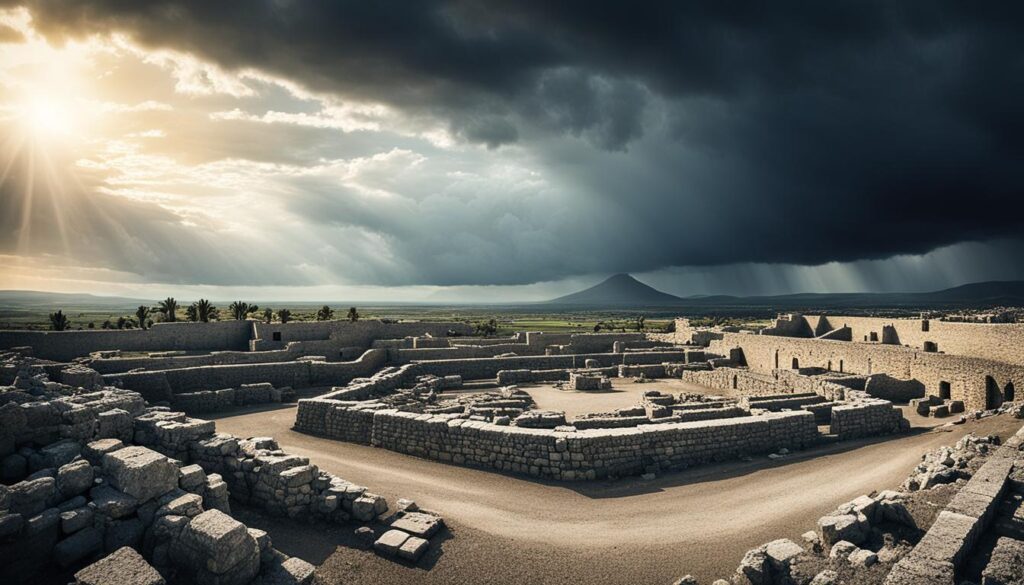
| Key Points | Details |
|---|---|
| Armageddon | The final battle that will occur at Megiddo in the end times, symbolizing the ultimate conflict between good and evil. |
| Divine Intervention | Belief in God’s intervention to deliver his people and establish a new order of peace and righteousness. |
| Eschatological Teachings | Megiddo’s prophetic significance shapes theological discussions and influences interpretations of biblical prophecies. |
| Hope and Inspiration | The enduring belief in Megiddo’s role in biblical prophecy offers believers hope and inspiration for the future. |
Conclusion
Megiddo, with its historical battles, geographical location, archaeological discoveries, and theological significance, holds a prominent place in the Bible. The site’s role in biblical prophecy, particularly as the potential setting for the final battle, adds to its allure and importance in religious teachings. Exploring Megiddo deepens our understanding of biblical history and provides insights into its cultural and religious context.
As mentioned in the Old Testament and the book of Revelation, Megiddo has played a significant role in ancient battles and is associated with key biblical events. The site’s strategic location on the Via Maris trade route and its access to fertile lands made it a coveted prize throughout history.
The archaeological excavations at Megiddo have revealed remarkable structures and artifacts from different time periods, shedding light on the material culture of ancient civilizations. These discoveries contribute to our knowledge of the biblical world and help us connect with the people who lived during those times.
Moreover, Megiddo holds profound theological significance, representing the ultimate conflict between good and evil in eschatological beliefs. The mention of Armageddon in the New Testament further solidifies the biblical prophecy associated with this ancient site. Its enduring legacy continues to captivate believers and scholars alike, making Megiddo an essential destination for those seeking a deeper understanding of biblical history and its profound implications.
FAQ
What is the biblical significance of Megiddo?
Why is Megiddo considered a historical battleground?
Where is Megiddo located?
What have archaeological excavations at Megiddo revealed?
What is the theological significance of Megiddo?
What key biblical events are associated with Megiddo?
What were the cultural and religious practices at Megiddo?
What is the prophetic significance of Megiddo?
What is the overall significance of Megiddo in the Bible?
Source Links
- https://www.artzabox.com/a/blog/megiddo-history-biblical-significance-and-relevance-today
- https://www.uwlax.edu/globalassets/offices-services/urc/jur-online/pdf/2005/westpfahl.pdf
- https://biblearchaeology.org/research/conquest-of-canaan/3084-megiddo-the-place-of-battles?gclid=Cj0KCQjwka_1BRCPARIsAMlUmEpgQzeFaMiTEgSTZYsXsHx2zJIP74yv-EFQdIhpMi4jS2-VacEGj1IaAvDmEALw_wcB
